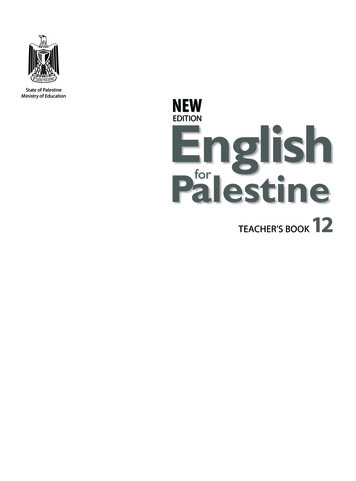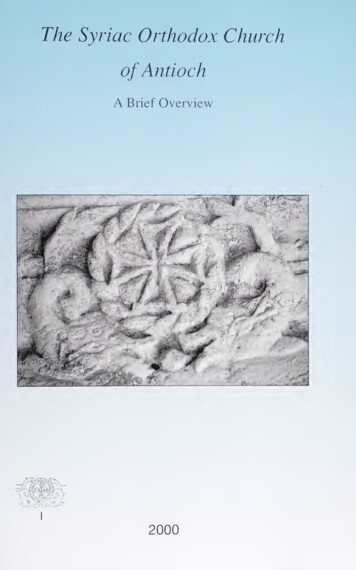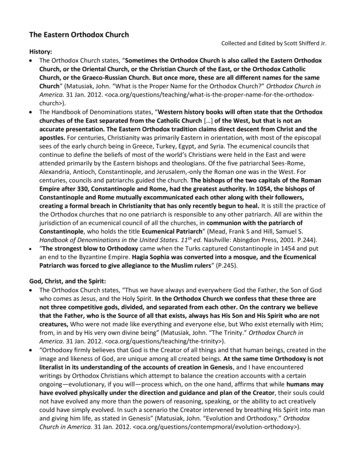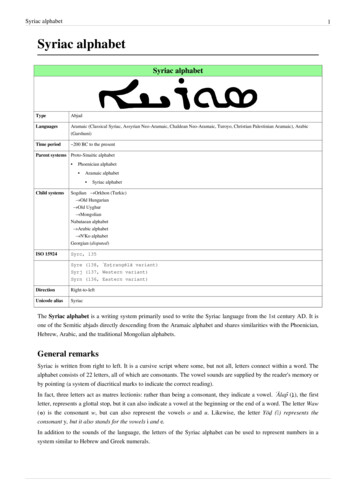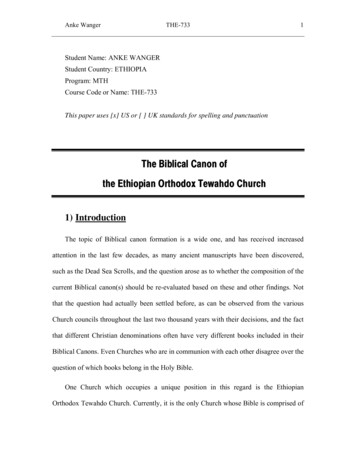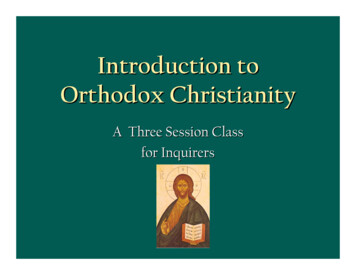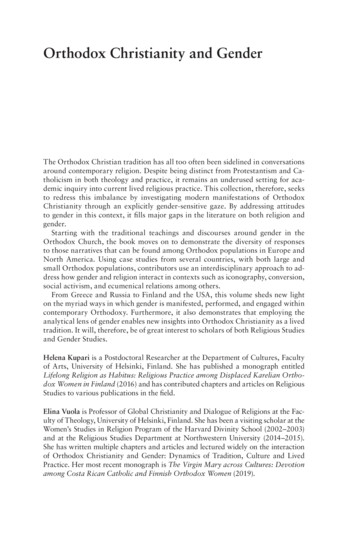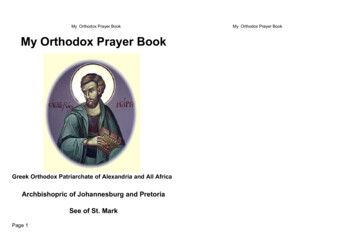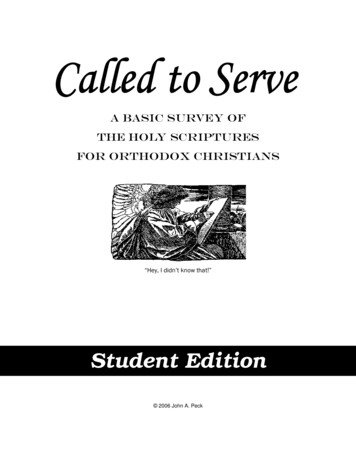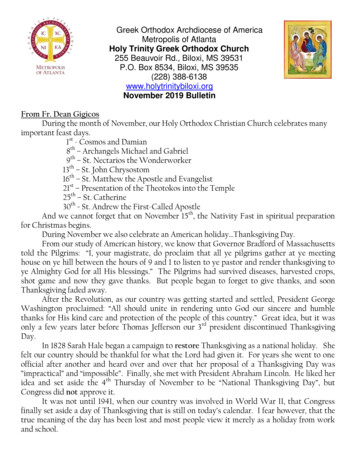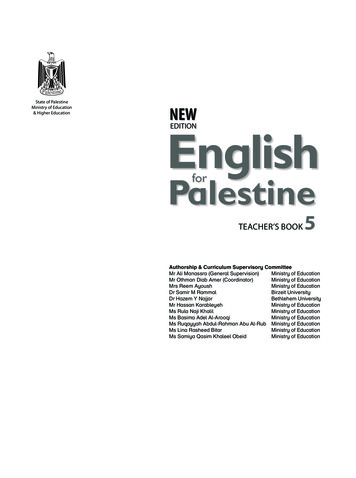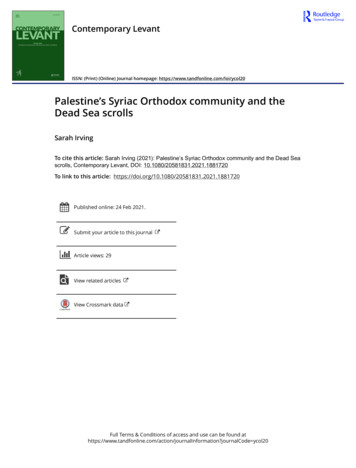
Transcription
Contemporary LevantISSN: (Print) (Online) Journal homepage: s Syriac Orthodox community and theDead Sea scrollsSarah IrvingTo cite this article: Sarah Irving (2021): Palestine’s Syriac Orthodox community and the Dead Seascrolls, Contemporary Levant, DOI: 10.1080/20581831.2021.1881720To link to this article: shed online: 24 Feb 2021.Submit your article to this journalArticle views: 29View related articlesView Crossmark dataFull Terms & Conditions of access and use can be found ation?journalCode ycol20
CONTEMPORARY 0Palestine’s Syriac Orthodox community and the Dead Sea scrollsSarah IrvingEdge Hill University, Ormskirk, UKABSTRACTKEYWORDSIn 1947, a shepherd in the hills north of the Dead Sea visited a contact inBethlehem, a dealer of antiquities to foreign visitors, offering fragments ofwritten material. The dealer, from the Syriac community, was unsure of theitems’ value and began enquiries which followed Syriac Orthodoxreligious and intellectual networks. Despite initial scepticism, thefragments were the first of the now globally famous Dead Sea Scrolls,and ever since have been surrounded by rumours and controversy.Inextricably entwined in these has been the Palestinian Syriac Orthodoxchurch, in a pattern of involvements which link this small Christiancommunity with the creation of knowledge in and about MandatePalestine, the fate of its members during the Nakba, and internalcompetition for ownership of valuable resources in a communityfragmented by the 1947–1949 conflict. In this paper, I reconstruct therole of Syriac Orthodox community members in the discovery of theDead Sea Scrolls, examining how the parts they played were informedby their status in late Mandate Palestine. As a counterpoint to this, thecase also highlights how the needs of the community – particularly inthe wake of the Nakba – were tied to a kind of cultural diplomacy asthe head of the church in Jerusalem, Mar Samuel, sought to frame hiscommunity as refugees, as Christian Palestinians, and as owners andvalid beneficiaries of Palestinian archaeological heritage.Dead Sea Scrolls; Ta’amiraBedouin; Syriac Orthodox;Palestine; Bethlehem;JerusalemIn 1947, a member of the Ta’amira pastoralists from the hills north of the Dead Sea in MandatoryPalestine visited a contact in Bethlehem, a merchant who, amongst other things, sold antiquitiesto foreign visitors and archaeologists, offering fragments of written material. The dealer, amember of the Syriac Orthodox community,1 was unsure of the items’ value and began a seriesof enquiries which followed Syriac networks including the Metropolitan of Jerusalem, AthanasiusYeshue Samuel, the scholar Stephan Hanna Stephan at the Palestine Archaeological Museum (alsoa Syriac Orthodox from Bethlehem), as well as several other Syriac clergymen and members ofthe community who worked at European institutions in Jerusalem.Despite initial scepticism from Stephan and others, the fragments were the first finds from thenow globally famous Dead Sea Scrolls, and ever since their discovery have been surrounded byrumours, ownership claims and counter-claims, and controversy. The Syriac Orthodox church inPalestine was inextricably entwined in the first two decades of these at the levels both of ordinarymembers and of its highest hierarchy, in a pattern of events which link this small Christian community with the creation of knowledge in and about Mandate Palestine, the fate of the community’smembers during the Nakba (Catastrophe, the displacement of c.750,000 Palestinians by the establishment of the State of Israel in 1948), and internal competition for ownership of valuable resourceswhich pitted individual against leadership claims in a community fragmented by the 1947–1949CONTACT Sarah Irvingsarahirvingwork@gmail.com 2021 Council for British Research in the LevantEdge Hill University, Ormskirk, UK
2S. IRVINGconflict. The discovery of the Scrolls took place amidst the rising violence between Jewish and Arabforces in Mandatory Palestine, the withdrawal of British forces and governmental functions, theestablishment of the State of Israel and the imposition of Jordanian rule on the West Bank. Theseevents embroiled refugees and displaced Palestinians, hardening borders which cut off contactbetween individuals and groups. The Scrolls were thus drawn into competing national narratives,with the Palestinian role rapidly subsumed beneath the claims to the scrolls made by Israel andJordan, whose rule over the West Bank included East Jerusalem and the Palestine ArchaeologicalMuseum.The political context thus runs through the entire story of the finding of the Dead Sea Scrolls, butis often presented only as incidental and inconvenient in Western accounts. Indeed, one of the veryfew accounts of discovery, negotiations and purchase surrounding the Scrolls which fully acknowledges the political context is that by the Israeli archaeologist and politician Yigael Yadin, who, alongwith his father, Eleazer Sukenik, was instrumental in buying the bulk of the Scrolls for the State ofIsrael. Yadin was a senior commander in the Haganah (the Zionist armed forces in Mandate Palestine)at the time of the Scrolls’ discovery, and his narration interweaves the wartime context with detailfrom his father’s diaries of the networks of churchmen, antiquities dealers and scholars throughwhose hands the Scrolls passed in these early moments (Yadin 1957).The political moment of the Dead Sea Scrolls’ discovery has therefore had a major impact on theway in which their story has subsequently been told: much of the initial ‘mystery’ around them,beloved of popular writers, stems not from conspiracies but from wartime disruption, and thevarious far-fetched theories about parts of the Scrolls being kept secret because of their explosivecontents in relation to Christianity are actually the results of post-war hostility between Israel andJordan, combined with later mismanagement of the publication project.2 In this paper, I endeavourto reconstruct the role of members of the Syriac Orthodox community in the discovery and sale ofthe Scrolls, viewing them as a network and examining the ways in which the interlinked parts theyplayed were informed by their status as Christians, scholars, officials or religious leaders in lateMandate Palestine. What happens to the conventional narrative of the Scrolls’ discovery if we foreground Palestinian activity, paying attention to a historical context of archaeology, antiquities saleand intercommunal relations which extends back into the Ottoman period?In order to do so, this article focuses on the initial months after the small group of Ta’amiraBedouin men who found the first Scrolls brought them to Bethlehem and launched them into thelocal antiquities market. This period is reconstructed from the various accounts published, mainlyin the 1950s and 60s, by American and European archaeologists who became involved with theScrolls after this phase of their history, but who endeavoured – mainly through interviews – tofind out how and where the Scrolls had come to light. There is very little formal archival materialon these months, whether in Arabic or colonial languages, because the activities of the Bedouinsellers and their Syriac Orthodox go-betweens were of necessity secretive and clandestine. My portrayal of the Syriac community’s involvement is thus built up from a combination of these resourcesand from the often contradictory and mutually antagonistic autobiographical writings of two men atthe heart of the process, Metropolitan Athanasius Yeshue Samuel and Anton Kiraz. The focus ismainly on anglophone and occasionally francophone literatures because they are the main international languages of what has become known as ‘Qumranology’; indeed, the extent to which scholarship and discourses of ownership around the Scrolls has been captured by Israeli and EuroAmerican interests is highlighted by the extreme scarcity of studies in Arabic, especially fromJordan, the country which still holds one of the most striking finds, the Copper Scroll (Zayadine2009, p. 113). With the exception of letters from the Harvard Semitic Museum which cast somelight on the attitudes of American archaeologists to the Palestinians embroiled in the Scroll story,most of the sources used in this article are thus in the public domain, albeit in some cases (suchas Archbishop Samuel’s autobiography) now largely ignored. My contribution is to read themagainst the grain, paying close attention to the orientalist and colonialist narratives which dominatemuch academic and popular Scroll literature, and considering instead how the contemporary
CONTEMPORARY LEVANT3hegemonic narrative of the Scrolls hides their significance for Palestinian histories in favour of theirJewish and Christian religious importance. Refocusing the narrative of the Scrolls’ discovery onto thePalestinians who discovered and brokered them, reinscribing these world-famous artefacts back intoa specifically Palestinian history, is a reminder of the ethically problematic and complex route takenby these and many other antiquities from the region, relocating the question of the Scrolls withinwider debates about cultural heritage and ownership as well as within studies of how refugee populations seek to shape their own self-representation. It therefore also represents a case study of howthe Syriac Orthodox of Palestine operated in a particular niche within wider society before 1948,3 andhow this community experienced the Palestinian Nakba, the initial years of dispersal, and the politicsof aid and refugeehood.Framing the Dead Sea ScrollsAccounts of the discoveries of the Dead Sea Scrolls, a collection of manuscripts dating from thedecades either side of the year 0AD, usually follow a similar format. The scrolls are found in cavesin the hills above the Dead Sea by Bedouin shepherds around the turn of the year 1946/47; theythen pass through the hands of various shadowy figures in Bethlehem and Jerusalem, and fromthence to their proper owners, defined (according to the position of the writer) either as anetwork of international scholars and ‘experts’ who can properly interpret them, or as the Israelistate and the museum it has erected especially for these objects.4 Even scholarly books on thescrolls, in their brief copy-and-paste accounts of the discovery, sometimes wrongly state that theywere found on Jordanian territory, although the land was under Palestine Mandate rule until ayear or more after the initial finds (e.g. Flint 2013, p. 5) or confuse the Syriac Orthodox faith or Assyrian ethnicity of key figures with Syrian nationality (e.g. Collins 2013, p. 4, 8, 33).Indeed, it is noteworthy that scholarly discussions of the Scrolls rarely engage with the story oftheir discovery at all; the focus of attention is on the manuscripts’ contents. Most of the existing information on the early days of the Scrolls’ re-entry into the world thus comes from ‘popular’ bookswritten by many of those involved in their purchase and early interpretations and published bytrade presses. Common discourses underlying these narratives include the idea of the Scrolls asobjects of unparalleled value in Jewish history, understood as having implications for their rightfulownership, and/or notions of global heritage which position valuable archaeological finds and,indeed, places such as the city of Jerusalem as outside the claims of individuals or peoples and assubject to a kind of international patrimony. Questions of religion/religious history and academicexpertise tend to dominate, whilst the extent to which the early years of the Scrolls’ return tohuman sight are entwined with the displacement of the Arab-Palestinian people, orientalism,legal infringements and extra-judicial violence is largely swept aside. Indeed, the mere presenceof Palestinians in the process of the discoveries is at times presented as a source of confusion,error, delay and disorganisation.5 And even now, more than 70 years after the initial discoveries,the Dead Sea Scrolls – or forged fragments sold as part of them – still make headlines in storieslargely focused on the idea that the documents represent a link to a pivotal period of Jewishhistory or, less realistically, to quasi-mystical stories of the life of Christ or conspiracy theories orchestrated by the Vatican (Collins 2013, ix, Elgvin and Langlois 2019, pp. 113–114).But the Dead Sea Scrolls were discovered, handled, weighed up, bartered and sold by ordinaryinhabitants of the land, following well-established routes along which antiquities had passed(with varying degrees of formal legality) from rural peasants and pastoralists to urban dealers andthence to foreign scholars since at least the early nineteenth century (Fields 2009, pp. 25–26, al-Houdalieh 2014, pp. 104–105). These were social and economic relationships which, more often thanlucrative antiquarian discoveries, also channelled cheese, sheepskins and other quotidian objectsfrom the countryside to Palestine’s towns and cities (Schölch 1993, pp. 98–102, 131, 143–145,Fields 2009, p. 26). The scrolls might themselves be extraordinary items, but their discovery, farfrom being the tale of intrigue portrayed by many Euro-American writers, followed everyday
4S. IRVINGpatterns which became mysterious only as far as was necessary for the actors within them to circumvent the legal framework of the British Mandate administration’s Department of Antiquities. Thescrolls, and their story, has, however, been distorted, elements of it amplified out of all proportion,by the kind of ideological and emotional furore which surround many archaeological discoverieswith Biblical links (Brodie and Kersel 2012). The focus on the Scrolls and their theological importancehas, moreover, obscured much of the archaeological context, with non-documentary finds from thevarious caves often dispersed around the world and their significance for understanding the site lost;a recent project to trace these objects is one of the few scholarly enterprises which seems to take theTa’amira Bedouin and their activities seriously, in the interests of reconstructing from various interviews and secondary accounts their exact activities in the 1940s and 50s (Taylor et al. 2017).Reframing the discovery of the Dead Sea Scrolls in an Arab- and Syriac-Palestinian context is nota matter of writing new characters into the story, but instead requires a shift in how we think aboutantiquities. Much writing on archaeological discoveries is founded on the assumption that ancientitems rightfully belong in the hands of a scientific scholarly community (one rooted in capitalistand colonialist power structures and global relations) who will study and preserve them, and ifthey are significant enough display them in museums and galleries (Abu El-Haj 2001, Field et al.2016, p. 5). This model of knowledge formation and ownership has been increasingly challengedby the claims of indigenous peoples and formerly colonised nations to ownership of their heritage,and by debates within the discipline of archaeology since at least the 1980s (e.g. Trigger 2002,Given 2004, Anderson and Rojas 2017). Although many popular depictions of archaeology arestill centred on a lone white male explorer, within academia discussions of the ethics of excavation,its relationship to past and present communities and questions of how finds should be handledand interpreted are very much alive and influencing the practice of field archaeologists,museum curators, funding organisations and other actors (e.g. Atalay 2012 Gnecco and Lippert2015, Abu-Khafajah and Miqdadi 2019), as well as discussions of those active in the past (Griswold2020, Meskell 2020).Much of the public debate around return of antiquities to their countries of origin is, however,rooted in the notion that there is a single rightful owner, usually identified with the nation-stateand its institutions, such as national museums (Field et al. 2016, p. 8), effectively excluding ordinarypeople and their everyday relationships with ancient objects. Such formulations become especiallyproblematic in situations where the legitimacy of the state is itself ambiguous; in the contemporarysetting, this issue is complicated by the absence of a Palestinian state. In the historic setting, it isevoked especially in the power imbalances between colonised and colonising peoples and otherenvironments in which the state is seen as illegitimate; in these cases, standard tropes of ‘looters’and corrupt antiquities dealers need to be subjected to a series of questions (Field et al. 2016,Barker 2018). Why would someone discovering an ancient object whilst living under an oppressivecolonial regime necessarily see that regime as the safest or most legitimate owner of that antiquity?Why, if an ordinary person discovering an item knew that reporting it to official authorities could leadto major disruption to their livelihood or to expropriation of their land, would this seem like the mostlogical choice? And why, if someone living under a colonial regime they deemed illegitimate discovered an ancient object, might they not with good reason view themselves as having an equal, if notgreater, right to the proceeds of their finds, rather than a duty to submit them to the gatekeepers of avague ‘heritage of humankind’ whose main beneficiaries appeared to be colonial elites? As BrentNongbri has written of the Egyptian peasants and antiquities dealers whose networks form the backdrop to many discoveries of early Christian manuscripts, whilst the intentions and information oflocal and indigenous peoples should be subject to critical scrutiny, so should those of Euro-Americanscholars (Nongbri 2018, p. 15). In addition, however, we also need to integrate ideas such as JamesScott’s ‘weapons of the weak’ into our understanding of the former’s positionality – of antihegemonic choices of how to deal with antiquities as tactics for managing, if not resisting, the impacts ofcolonialism (Ibid.; see also Scott 1985).
CONTEMPORARY LEVANT5Narrating the discovery of the Dead Sea ScrollsThe story of the Scrolls’ discovery starts with Muhammad Ahmad el-Hamed, also known as al-Dhib, aTa’amira Bedouin man from the area between Bethlehem and the Dead Sea. Along with his companions Jum’a Muhammed and Khalil Musa,6 in late 1946 or early 1947 one of the men apparentlyfound the opening to a cave whilst looking after his sheep and goats in the hills. Such caves arecommon in the region, and sometimes contained items of archaeological interest which thefinders sold on to supplement their normal income (Shanks 1998, pp. 9–10, Fields 2009, p. 25).Muhammad el-Hamed is often portrayed, in orientalist fashion, as a naïve figure, sometimes evendescribed as a ‘shepherd boy’ or ‘lad’ (see, e.g., Burrows 1955, p. 4, Allegro 1956, p. 13, Samuel1968, pp. 142–143, Shanks 1998, p. 3); he was around 15–17 at the time of the discovery – young,but in his community old enough to have substantial responsibilities. Various scholars also note,with varying degrees of (dis)approval, that during searches for more manuscripts the Bedouin successfully located and excavated entire caves which had gone unnoticed by the ‘experts’ from Jerusalem who were digging at Qumran and Ein Feshka in the 1950s (Burrows 1958, pp. 5–14, De Vaux1967, pp. 319–320, Shanks 1998, xiii), while Bedouin labourers were simultaneously employed on theexcavations (De Vaux 1967, p. 335, 1973, p. 97, Hirschfeld 2004, p. 16, 20). The very fact that Bedouininvolvement in illicit digging is almost always mentioned in descriptions of the discovery of thescrolls, but their presence as employees on official excavations is rarely noted, highlights the orientalist tendencies of most Euro-American narratives. The most marked example of this is the finder ofthe first scrolls himself, Muhammad, who is usually referred to using his enigmatic kunya, ‘the Wolf,’but of whom it is rarely noted that he was employed as an archaeological labourer both at Qumran in1952 (De Vaux 1967, p. 335) and later near Nablus (Kiraz 2005, p. 143).Some time after Muhammad el-Hamed found the initial scroll fragments and jars (accounts rangefrom days to months), one of his relatives, possibly Jum’a Muhammed (Kiraz 2005, xviii) visited Bethlehem on a regular route to sell the products of the family’s pastoral economy (Allegro 1956, p. 15).On arriving in town, he consulted various people already known to him, including members of thesame tribe who had settled in the city, and various Bethlehemites who they knew were involved inselling antiquities, some of them on a casual and illicit or semi-licit basis alongside their main livings,which ranged from selling souvenirs to tourists or cloaks in Bedouin settlements to shipping stonemined around the Dead Sea (Samuel 1949, p. 26, Shanks 1998, p. 9, Kiraz 2005, xviii, 112). Followingwhat was probably an established way of doing business, Jum’a Muhammed consulted the lattergroup of men to find out what they might be willing to pay or to arrange to leave items withthem so that they could search out buyers from amongst the private collectors, academics andmuseum staff who might be interested in the Scrolls and willing to overlook the fact that theyhad not, as the law required, been reported to the Mandate authorities (Shanks 1998, p. 9). Thesecontacts amongst the antiquities dealers and merchants of Bethlehem were Ibrahim Ijha, DaoudMusallam, Faidi Salahi, (probably also known as Faidi al-‘Alami), Khalil Iskander Shahin (often referredto as Kando) and George Isha’ya Shamoun (also spelt Shaya, Isaiah in various accounts; Samuel 1968,pp. 141–167, Fields 2009, pp. 26–29; Shanks 9-10, 15-16, Burrows 1955, p. 5). Of these, Khalil Shahin,George Isha’ya and possibly others were members of the Syriac Orthodox community who, like otherChristian denominations in pre-1948 Palestine and for a variety of socio-economic reasons, oftenoccupied ‘in-between’ socio-economic roles – translators, dragomans, officials, journalists, photographers, ‘fixers’, and producers and sellers of the types of items that would be of interest to foreignvisitors (Norris 2013; Haiduc-Dale 2013, 27, 29, 85-86, 143). The connections used to find buyersfor the first batch of Dead Sea Scrolls were, therefore, firmly embedded in the wider social and economic networks which ran through Mandate Palestine society.Four of this original batch of scrolls were passed to Khalil Shahin and thence to ArchbishopAthanasius Yeshue Samuel of the Syriac Orthodox church, and his acquaintance Anton Kiraz, aSyriac taxi company owner from Bethlehem. The competing claims of Kiraz and Samuel –which are dealt with at greater length below – were fought out in the press and threats of
6S. IRVINGlegal action, but behind them lay a number of other internal disputes within the Syriac Orthodoxchurch in Palestine. The other three scrolls had a less dramatic, and for the purposes of this articleless informative, trajectory. One of the three Bedouin finders – it is not clear from the conflictingaccounts which – sold his share of the scrolls to Faidi Salahi in Bethlehem; Kiraz described Salahiin a letter as ‘a dealer of antiquities all his life’ and thus as being well-acquainted with figures inthe world of Jerusalem antiquities and archaeology (Kiraz 2005, p. 65). Salahi contacted LevonOhan, an Armenian friend whose father, Nasri, was an established antiquities dealer in Jerusalem(Yadin 1957, pp. 21–24, Shanks 1998, p. 10, Fields 2009, p. 41). Ohan, in turn, got in touch withEleazar Lipa Sukenik, Professor of Archaeology at Hebrew University, and showed him fragmentsat a November 1947 meeting point between the military zones into which Jerusalem was dividedin the months before the British withdrawal. They arranged a risky bus trip to Bethlehem, whereSukenik arranged to buy three of the scrolls from Salahi (Yadin 1957, pp. 15–20, Shanks 1998, p.12, Fields 2009, pp. 41–450).It is notable that most of the conventional accounts of the Scrolls’ discovery persist in referring toKhalil Shahin by his local nickname of Kando, in a way that can – whatever the name’s social functionwithin Bethlehem – be read as dismissive and disrespectful. Almost certainly they would never referto a fellow scholar, a government official or any other Westerner in a similar way, but Shahin is‘Kando, the quondam Syrian cobbler of Bethlehem’ (Fitzmyer 1974, p. 391, 1976, pp. 214–215). Asimilar dynamic is found in the habit (albeit in private correspondence) of senior US archaeologistssuch as Carl Kraeling of referring to Metropolitan Samuel as ‘Bushy-beard’ (e.g. Kraeling to Albright,31st December 1949, ASOR Albright 002 1/4 Correspondence 1949). Muhammad el-Hamed, Jum’aMuhammed, Khalil Musa and their friends and family are even more faceless, as ‘the Bedouin,’‘the Ta’amireh Bedouin’ or similar wording (eg Fitzmyer 1976, pp. 214–215, Hirschfeld 2004, p.16), whilst Orientalist images of the ‘noble savage’ echo through the emphasis placed by manyauthors on el-Hamed’s nickname al-Dhib, ‘the Wolf’ (e.g. Shanks 1998, pp. 3–7, Collins 2013, p. 4,Flint 2013, p. 2) and of the site of the scrolls’ discovery as a ‘howling wilderness’ (Cross 1954, p.4). There are exceptions – Hershel Shanks’ popular account, for example, robustly rejects narrativesof Bedouin naivete about their finds and pours scorn on the idea that Shahin would have used thescrolls he received to mend shoes (Shanks 1998, pp. 9–10), and Robert Boling’s overview of significant finds in the area credits Ta’amira ingenuity for many of the major discoveries and uses moreneutral language such as ‘unsponsored’ to describe their searches, as do some of Roland deVaux’s accounts (Boling 1969, pp. 82–84, De Vaux 1973, vii-viii, 49-53, 95-97). But in general, elHamed and his companions are framed in ways familiar from stereotypes of the ‘desert Bedouin’– naïve, mysterious, wild and unreliable, influenced by images from the Lawrence of Arabia genrewhich are a long way from the livelihoods of the Ta’amira, who had been at least semi-sedentaryin their habits for several hundred years (Schölch 1993, pp. 143–145, Layish 2011, pp. 16–19).Descriptions of the Syriac Orthodox merchants of Bethlehem can, meanwhile, be located withintropes of the ‘Levantine,’ rooted in racialised suspicions of liminal and hybrid figures which wereoften applied by Western commentators to Middle Eastern Christians and Jews, urbanised Arabs,dragomans and those ‘cosmopolitans’ not protected from suspicion by an upper-class socio-economic status (Eldem 2009, pp. 225–227, Chiti 2020, pp. 78–85).The scrolls in Syriac Orthodox handsIn order to find buyers for the scrolls, the middlemen in Bethlehem, who were merchants and businessmen of varying economic weight, tapped into another network, that of their Syriac Orthodoxcoreligionists in Jerusalem, many of whom belonged to the educated lower-middle class of the colonial setting. These men primarily worked in institutions such as the Palestine ArchaeologicalMuseum, the YMCA and European consulates, and were thus in direct contact with sources of colonial expertise and authority, but they also – via family and social and religious relationships – overlapped with the mercantile networks of Bethlehem. They intersected most notably at the centre of
CONTEMPORARY LEVANT7the Syriac Orthodox community in Palestine, the monastery and church of St Mark in the Old City ofJerusalem. This centuries-old institution marked the Syriac Orthodox as one of the various denominations which formed the complex Christian makeup of Mandate Palestine.The exact route that the various scrolls took from Bethlehem to Jerusalem remains unclear to thisday; Khalil Shahin (Kando) himself never recorded or wrote down his version of events before hisdeath in 1994 (Shanks 1998, p. 10), and the events involving Anton Kiraz and Archbishop Samuelremain the subject of claim and counter-claim as voiced in their personal accounts (Samuel 1949,Samuel 1968, Kiraz 2005). This section therefore seeks to reconstruct parts of the journey fromthe accounts of Samuel and Kiraz because of their centrality to the Syriac Orthodox theme of thispaper, supplemented by non-Syriac primary and secondary sources, particularly Weston Fields’detailed timeline. In doing so, I locate the history of the discovery of the Dead Sea Scrolls withina broader Palestinian history which also involves the Ta’amira Bedouin, the Palestinian Archaeological Museum and other local actors, but which also includes the workings of the religious and lay sections of the Syriac Orthodox communities of Jerusalem and Bethlehem, and some of the tensionsthat existed within them and between the Syriac church and the Mandate administration.7 This historical path is supplemented by a textual reading of Archbishop Samuel’s autobiography and theletters of Anton Kiraz, published by his son, in order to unpick some of the intra-communal dynamicswhich are uncovered by the story of the scrolls.According to Archbishop Athanasius Samuel, his encounter with the Dead Sea Scrolls began withGeorge Isha’ya, a member of his congregation, trying to attract his attention after a Sunday service atSt Mark’s in July 1947. In an account which mocks and patronises both Isha’ya and Shahin, Samueldifferentiates himself from the part-time antiquities dealers of Bethlehem and their role as brokersbetween himself and the Ta’amira Bedouin sellers (Samuel 1968, pp. 141–142). An initial meetingran aground when Father Bulos Jilif of St Mark’s monastery turned away Isha’ya, the two Bedouinwho had come to Jerusalem with him (probably Jum’a Muhammed and Khalil Musa), and the‘very dirty’ scrolls they wanted to show to the Metropolitan (Samuel 1949, p. 27, Burrows 1955, p.6, Fields 2009, pp. 29–30). According to Sa
Framing the Dead Sea Scrolls Accounts of the discoveries of the Dead Sea Scrolls, a collection of manuscripts dating from the decades either side of the year 0AD, usually follow a similar format. The scrolls are found in caves in the hills above the Dead Sea by Bedouin shepherds around the turn of the year 1946/47; they
